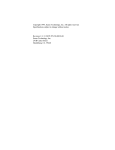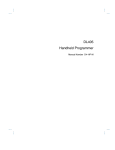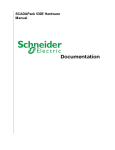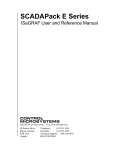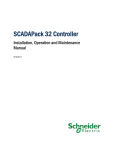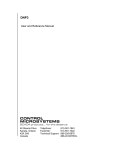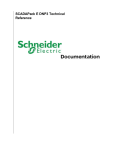Download SCADAPack E Koyo DirectNET PLC Interface Manual
Transcript
SCADAPack E Koyo DirectNET PLC Interface Manual 2 SCADAPack E Koyo DirectNET PLC Interface Manual Table of Contents Part I Koyo DirectNET PLC Interface 3 1 Technical ................................................................................................................................... Support 3 2 Safety ................................................................................................................................... Information 4 3 Preface ................................................................................................................................... 6 4 Overview ................................................................................................................................... 8 4.1 Master/Slave &.......................................................................................................................................................... DirectNET Addressing Terminology 9 4.2 I/O Board & PLC .......................................................................................................................................................... Data Types 10 5 Serial................................................................................................................................... DirectNET Master I/O Board Interfaces 11 5.1 Multiple I/O Boards .......................................................................................................................................................... 12 5.2 Koyo DirectNET .......................................................................................................................................................... Input Boards 13 Parameters 14 5.2.1 Input Board......................................................................................................................................................... 5.3 Koyo DirectNET .......................................................................................................................................................... Output Boards 15 ......................................................................................................................................................... Parameters 16 5.3.1 Output Board 5.4 DirectNET Registers .......................................................................................................................................................... 18 6 Operation ................................................................................................................................... 19 7 Data Conversion ................................................................................................................................... 21 7.1 Koyo DirectNET .......................................................................................................................................................... PLC Data Types 22 7.2 Koyo DirectNET .......................................................................................................................................................... Data Conversion 23 8 Communication ................................................................................................................................... Interface 25 9 Data Communication ................................................................................................................................... Protocol 26 9.1 Koyo DirectNET .......................................................................................................................................................... Serial Communication Format 27 HDR & DATA ......................................................................................................................................................... Format 28 9.1.1 9.2 LRC Calculation .......................................................................................................................................................... Method 29 10 System ................................................................................................................................... Points 30 10.1 Communication .......................................................................................................................................................... Status & Data Cache Time 32 10.2 PLC Output Board .......................................................................................................................................................... Default Background Update Rate 33 11 Diagnostics ................................................................................................................................... 34 Koyo DirectNET PLC Interface I 3 Koyo DirectNET PLC Interface ©2013 Control Microsystems Inc. All rights reserved. Printed in Canada. Version: 8.05.4 The information provided in this documentation contains general descriptions and/or technical characteristics of the performance of the products contained herein. This documentation is not intended as a substitute for and is not to be used for determining suitability or reliability of these products for specific user applications. It is the duty of any such user or integrator to perform the appropriate and complete risk analysis, evaluation and testing of the products with respect to the relevant specific application or use thereof. Neither Schneider Electric nor any of its affiliates or subsidiaries shall be responsible or liable for misuse of the information contained herein. If you have any suggestions for improvements or amendments or have found errors in this publication, please notify us. No part of this document may be reproduced in any form or by any means, electronic or mechanical, including photocopying, without express written permission of Schneider Electric. All pertinent state, regional, and local safety regulations must be observed when installing and using this product. For reasons of safety and to help ensure compliance with documented system data, only the manufacturer should perform repairs to components. When devices are used for applications with technical safety requirements, the relevant instructions must be followed. Failure to use Schneider Electric software or approved software with our hardware products may result in injury, harm, or improper operating results. Failure to observe this information can result in injury or equipment damage. 1 Technical Support Support related to any part of this documentation can be directed to one of the following support centers. 4 SCADAPack E Koyo DirectNET PLC Interface Manual Technical Support: The Americas Available Monday to Friday 8:00am – 6:30pm Eastern Time Toll free within North America 1-888-226-6876 Direct Worldwide +1-613-591-1943 Email [email protected] Technical Support: Europe Available Monday to Friday 8:30am – 5:30pm Central European Time Direct Worldwide +31 (71) 597-1655 Email [email protected] Technical Support: Asia Available Monday to Friday 8:00am – 6:30pm Eastern Time (North America) Direct Worldwide +1-613-591-1943 Email [email protected] Technical Support: Australia 2 Inside Australia 1300 369 233 Email [email protected] Safety Information Read these instructions carefully, and look at the equipment to become familiar with the device before trying to install, operate, or maintain it. The following special messages may appear throughout this documentation or on the equipment to warn of potential hazards or to call attention to information that clarifies or simplifies a procedure. The addition of this symbol to a Danger or Warning safety label indicates that an electrical hazard exists, which will result in personal injury if the instructions are not followed. This is the safety alert symbol. It is used to alert you to potential personal injury hazards. Obey all safety messages that follow this symbol to avoid possible injury or death. Koyo DirectNET PLC Interface 5 DANGER DANGER indicates an imminently hazardous situation which, if not avoided, will result in death or serious injury. WARNING WARNING indicates a potentially hazardous situation which, if not avoided, can result in death or serious injury. CAUTION CAUTION indicates a potentially hazardous situation which, if not avoided, can result in minor or moderate injury. CAUTION CAUTION used without the safety alert symbol, indicates a potentially hazardous situation which, if not avoided, can result in equipment damage.. PLEASE NOTE Electrical equipment should be installed, operated, serviced, and maintained only by qualified personnel. No responsibility is assumed by Schneider Electric for any consequences arising out of the use of this material. A qualified person is one who has skills and knowledge related to the construction and operation of electrical equipment and the installation, and has received safety training to recognize and avoid the hazards involved. BEFORE YOU BEGIN Do not use this product on machinery lacking effective point-of-operation guarding. Lack of effective point-of-operation guarding on a machine can result in serious injury to the operator of that machine. CAUTION EQUIPMENT OPERATION HAZARD Verify that all installation and set up procedures have been completed. Before operational tests are performed, remove all blocks or other temporary holding means used for shipment from all component devices. 6 SCADAPack E Koyo DirectNET PLC Interface Manual Remove tools, meters, and debris from equipment. Failure to follow these instructions can result in injury or equipment damage. Follow all start-up tests recommended in the equipment documentation. Store all equipment documentation for future references. Software testing must be done in both simulated and real environments. Verify that the completed system is free from all short circuits and grounds, except those grounds installed according to local regulations (according to the National Electrical Code in the U.S.A, for instance). If high-potential voltage testing is necessary, follow recommendations in equipment documentation to prevent accidental equipment damage. Before energizing equipment: Remove tools, meters, and debris from equipment. Close the equipment enclosure door. Remove ground from incoming power lines. Perform all start-up tests recommended by the manufacturer. OPERATION AND ADJUSTMENTS The following precautions are from the NEMA Standards Publication ICS 7.1-1995 (English version prevails): Regardless of the care exercised in the design and manufacture of equipment or in the selection and ratings of components, there are hazards that can be encountered if such equipment is improperly operated. It is sometimes possible to misadjust the equipment and thus produce unsatisfactory or unsafe operation. Always use the manufacturer’s instructions as a guide for functional adjustments. Personnel who have access to these adjustments should be familiar with the equipment manufacturer’s instructions and the machinery used with the electrical equipment. Only those operational adjustments actually required by the operator should be accessible to the operator. Access to other controls should be restricted to prevent unauthorized changes in operating characteristics. 3 Preface Purpose The purpose of this document is to describe the SCADAPack E RTU driver for Koyo DirectNET protocol, its interface with ISaGRAF, and using it for communicating with PLC devices. The SCADAPack E RTUs provide a PLC interface for serial Koyo DirectNET PLC devices. Koyo DirectNET PLC Interface References SCADAPack E ISaGRAF Technical Reference manual ICS / Triplex ISaGRAF User Manual PLC Direct Inc., "DirectNET User Manual", 1994, part no. DA-DNET-M PLC Direct Inc., "DirectSOFT User Manual", 1994 7 8 4 SCADAPack E Koyo DirectNET PLC Interface Manual Overview Master/Slave & DirectNET Addressing Terminology I/O Board & PLC Data Types 10 9 Koyo DirectNET PLC Interface 4.1 9 Master/Slave & DirectNET Addressing Terminology Master/Slave Terminology PLC devices may communicate with the SCADAPack E RTU using ISaGRAF Slave I/O boards. PLC device elements are read and the return values cached in the RTU for access through an ISaGRAF input board. Similarly, ISaGRAF output board data can be transferred to the PLC. The RTU’s interface with ISaGRAF is described in detail in the SCADAPack E ISaGRAF Technical Reference manual. The status (quality) of the data read from a PLC device is present in RTU system points that can be accessed from within ISaGRAF or external to the RTU. When using ISaGRAF Koyo DirectNET PLC I/O boards for communication with a Koyo DirectNET PLC device, or devices, the SCADAPack E RTU is a Koyo DirectNET Master. The PLC device(s) need to be Koyo DirectNET Slave(s). DirectNET Addressing Terminology As used in the Koyo DirectSoft programming environment, the SCADAPack E RTU uses Octal Vmemory address numbering for V-memory and Octal C-register numbers for C-registers. A V-memory address specifies which 16 bit register maps to the first I/O channel on the ISaGRAF board. A C-register address specifies which C register bit maps to the first I/O channel on the ISaGRAF board. These register addresses are converted to Data Type and Hexadecimal DirectNET Reference Address for use by the DirectNET protocol. The user does not have to deal directly with these Data Types or reference addresses. For example: 1. A V memory read is done by a koyV..ai ISaGRAF I/O board specifying an address of 01400 (in octal). The RTU then sends a DirectNET Data Type 31, V-memory reference address 0x0301 read request to the PLC. 2. A C register read is done by a koyC..di I/O board specifying an address of 0020 (in octal). The RTU then sends a DirectNET Data Type 33, Output reference address 0x0183 read request to the PLC. See Section DirectNET Registers 18 for details on reference address ranges and Data Types. 10 4.2 SCADAPack E Koyo DirectNET PLC Interface Manual I/O Board & PLC Data Types I/O Board Types Where a SCADAPack E RTU has one or more of its serial ports configured as ‘PLC Device’ and koy.. ISaGRAF I/O boards are used, the RTU communicates using serial “Koyo DirectNET” protocol. The settings of the RTU communication port data rates and parity format configurations are used by the Koyo DirectNET PLC device driver. RS232, RS422 and RS485 communications are supported. PLC Data Types PLC devices present data in a variety of ways through register interfaces. The SCADAPack E RTU supports the following commonly used data types when communicating with Koyo DirectNET devices. IEC DISCRETE - discrete input/output/c register (bit) data in IEC61131-3 international standard format IEC UINT - unsigned 16-bit integer data (values 0 ~ 65535) IEC DINT - signed 32-bit integer data (value –231 ~ 231-1) in IEC61131-3 international standard format IEC REAL - 32-bit floating point (real) data in IEEE-754 international standard format See Section Data Conversion RTU. 21 detailing the use of these PLC Data Types with the SCADAPack E Koyo DirectNET PLC Interface 5 11 Serial DirectNET Master I/O Board Interfaces The koy.. ISaGRAF boards use the SCADAPack E RTU ‘PLC Device’port to communicate with Koyo DirectNET peripheral devices (herein described as PLCs). Multiple I/O Boards 12 Koyo DirectNET Input Boards 13 Koyo DirectNET Output Boards DirectNET Registers 18 15 12 5.1 SCADAPack E Koyo DirectNET PLC Interface Manual Multiple I/O Boards Multiple I/O boards may be configured within the same ISaGRAF application. Each I/O board can access different PLC register data within the same PLC device, or where external physical connections permit or where multiple RTU serial ports are used, multiple I/O boards can also access PLC register data in multiple PLC devices. For example, one multi-drop RS485 will allow uniquely addressed Koyo DirectNET PLCs to be connected to a single SCADAPack E RTU serial port. Two Koyo DirectNET PLCs can each be connected to a separate RTU serial port, where both serial ports are configured as ‘PLC Device’ ports. Each the ISaGRAF application’s PLC I/O boards uses a separate DirectNET request to read or write its data. Improved DirectNET communication efficiency can be achieved by grouping DirectNET registers together and using less I/O boards with a larger number of channels per board (eg. KoyV64ai), rather than more I/O boards with a smaller number of channels. A maximum of 100 Slave I/O Boards may be configured for PLC communications, in total, for every communication port and across both RTU ISaGRAF Applications. Recall, also that each ISaGRAF application has a total limit of 255 I/O boards for each board type. Communication status is available on the first 60 I/O boards for ISaGRAF kernel 1, and 14 I/O boards for ISaGRAF kernel 2. See Section System Points 30 for more information. ISaGRAF “Complex Equipment” types are comprised of configurations similar to I/O boards. Where a Complex Equipment type includes PLC Device I/O board configurations, each such I/O board configuration within the Complex Equipment type counts towards the limit of 100 slave I/O boards on that communications channel. A corresponding pair of system points relates to each PLC Slave I/O board on the lowest RTU port number, as described in Section System Points 30 . Figure 5.1: ISaGRAF Project Multiple I/O Boards PLC device communications using these I/O boards can be controlled by an ISaGRAF function block: koyoctrl. Koyo DirectNET PLC Interface 5.2 13 Koyo DirectNET Input Boards Koyo DirectNET PLC Input Board variables are updated at the start of the ISaGRAF application scan. The value presented to the ISaGRAF variables is the value returned by the PLC in response to the previous read request. This read may have occurred during previous ISaGRAF application scans. The “data update rate” parameter on the I/O board sets the "scan" rate of the PLC data. Controlling PLC Device Communications PLC device communications using these I/O boards can be controlled by an ISaGRAF function block: koyoctrl. The En_RD parameter on the block affects PLC device Input Boards. For more information see SCADAPack E Function Block Reference manual for more information. "OPERATE" on Input Boards The ISaGRAF “OPERATE” function may be used on a DirectNET PLC Input Board variable provided that the PLC register read by the input board can also be written. This permits PLC registers to be inputs into ISaGRAF, but have them “Preset” in the PLC by the ISaGRAF application. For more information see the SCADAPack E ISaGRAF Technical Reference manual. PLC device communications resulting from the use of the OPERATE function can be controlled by an ISaGRAF function block: koyoctrl. The En_WR parameter on the block affects control operations being sent to the PLC device. For more information see SCADAPack E Function Block Reference manual for more information. 14 5.2.1 SCADAPack E Koyo DirectNET PLC Interface Manual Input Board Parameters first_register: for koyV.. specifies the DirectNET PLC V registers to access when reading from PLC data into ISaGRAF variables. The PLC data type accessed is specific to the Slave PLC I/O board type and board address (see the table below). For koyC.. specifies the DirectNET PLC C registers to access when reading from PLC data into ISaGRAF variables. Only the C register at the start of each byte can be specified as an address. Valid C register addresses are 0, 10, 20, 30, 40 etc (in octal) plc_data_type: specifies the DirectNET PLC data register type. Various PLC data types are supported for Boolean and Analog boards. See Section Data Conversion 21 for more information. data_update_rate: The units for this parameter are set in milliseconds, and specify the rate at which the data for the Input board is extracted from the PLC. Individual I/O boards may have different data update rates allowing prioritisation of data extracted from a PLC Device. The RTU may not be able to read requested PLC data within the time set by the data update rate depending on the quantity of data to be read, rate of write requests and PLC communication speed. In this case the update rates will be slower. plc_device_addr: This parameter specifies the PLC device address. Koyo DirectNET PLC devices on the same communication channel (e.g. multi-dropped or bridged) need to have unique device addressing in order to be identified. ISaGRAF may access data from multiple PLCs via the same communication interface. In this case a separate I/O board will be required for each PLC device. Values for this parameter are usually in the range 1-90. timeout: The DirectNET PLC device driver provides a parameter for specifying the communications timeout on an individual I/O board (i.e. the timeout applies to communications associated with that board). Where this value is “0”, the PLC device driver will use the default timeout (500ms). Units for this field are in milliseconds. port: This parameter defines which of multiple SCADAPack E RTU “PLC Device” ports will be used to communicate with the PLC. If only one “PLC Device” port is configured on the RTU, this field is ignored. In the above koyV16di example, PLC #5 registers are read every 10 seconds into the ISaGRAF variables on I/O channels 1 through 16. A single register is read for the entire I/O board as the PLC data type specifies discrete variables (IEC DISCRETE). So V memory register 4210 (0x889 is read. The 16 bits of the register are mapped to the 16 I/O board channels. The default PLC timeout of 500ms is applied as the board’s “timeout” value is 0. Koyo DirectNET PLC Interface 5.3 15 Koyo DirectNET Output Boards ISaGRAF Output Board variables are updated at the end of the ISaGRAF application scan. ISaGRAF output variables are sent to the PLC when an ISaGRAF application changes the value of a variable attached to the Koyo DirectNET PLC Output Board. They are sent to the PLC after this occurs, but the ISaGRAF scan continues executing while the PLC communications are in progress. In addition, output board data is updated to the PLC under the following conditions: When the ISaGRAF application starts, output board data is written If the PLC does not respond to a control, it is re-sent until it is responded Output board data is written at a background “must write rate”. PLC device communications using these I/O boards can be controlled by an ISaGRAF function block: koyoctrl. The En_WR parameter on the block affects PLC device Output Boards. For more information see SCADAPack E Function Block Reference Manual for more information. 16 5.3.1 SCADAPack E Koyo DirectNET PLC Interface Manual Output Board Parameters first_register: for koyV.. boards, this field specifies the PLC data ‘V’ registers to access when writing from ISaGRAF variables to PLC data. The PLC data type accessed is specific to the PLC I/O board and board address. See Table 5.1 18 . For koyC.. boards, this field specifies the DirectNET PLC ‘C’ registers to access when reading from PLC data into ISaGRAF variables. Only the C register at the start of each byte can be specified as an address. Valid addresses are 0, 10, 20, 30, 40 etc (in octal) plc_data_type: specifies the Koyo DirectNET PLC data register type. Various PLC data types are supported for Boolean and Analog boards. See Section Data Conversion 21 for more information. plc_device_addr: This parameter specifies the PLC device address. Koyo DirectNET PLC devices on the same communication channel (e.g. multi-dropped or bridged) need to have unique device addressing in order to be identified. ISaGRAF may access data from multiple PLCs via the same communication interface. In this case a separate I/O board will be required for each PLC device. Values for this parameter are usually in the range 1-90. must_write_rate: The unit for this parameter is the millisecond, and specifies the rate at which all data for the Output board is written to the PLC. Between “must_write_rate” periods, data is written to the PLC only when the ISaGRAF output variable values change. Individual I/O boards may have different must write rates allowing prioritisation of data sent to a PLC Device. See Section PLC Output Board Default Background Update Rate 33 . timeout: The Koyo DirectNET PLC device driver provides a parameter for specifying the communications timeout on an individual I/O board (i.e. the timeout applies to communications associated with that board). Where this value is “0”, the PLC device driver will use the default timeout (500ms). Units for this field are in milliseconds. port: this parameter defines which of multiple RTU “PLC Device” ports will be used to communicate with the PLC device. If only one “PLC Device” port is configured, this field is ignored. In the above koyV8ao example, PLC #2 V memory registers 5777 through 6006 are set from variables on I/O channels 1 through 8. Holding registers are written in IEC UINT (16-bit unsigned integer format) when the ISaGRAF variable on the I/O channel changes, and at a rate of every 4 seconds even if they Koyo DirectNET PLC Interface don’t change. The PLC has 500ms (the default) to respond to a register write command for up to 8 registers. 17 18 5.4 SCADAPack E Koyo DirectNET PLC Interface Manual DirectNET Registers The following table describes the V-memory address ranges. koyV.. boards can be used to access any V-memory address with data type 31 (the user is not required to enter the data type). koyC.. boards can only be used to access the control relays with data type 33. These are addressed by C-register number in octal. Table 5.1: ISaGRAF Koyo DirectNET PLC Device I/O Board Register Access Memory Type V-memory Address (octal) Timer Current Time V00000 Counter Current Count V01000 V memory V01400 V memory V10000 GX (remote in) V40000 X (input points) V40400 Y (output points) V40500 Control Relays V40600 Stage Bits V41000 Timer Status Bits V41100 Counter Status Bits V41140 Special Relay V41200 C register Address – increments of 10 only (octal) 0-1770 Koyo DirectNET PLC Interface 6 19 Operation The SCADAPack E RTU ISaGRAF Koyo PLC Device Boards communicate to Direct Koyo PLCs using serial DirectNET communications protocol to Koyo CPU or DCM modules. Multi-drop Koyo PLCs are supported provided that the external physical interface allows it (e.g. RS485, RS232/RS422 via DCM modules, etc). For more information see Koyo DirectNET PLC documentation. Register Ranges For Koyo PLC types DL240, DL250, DL350, DL450, the ISaGRAF Koyo I/O Boards can access PLC “V” registers in the range 0 – 41237 (octal). PLC addresses configured on the Koyo ISaGRAF I/O boards are in Octal. RTU PLC Board Types Board Name ref ISaGRAF Data Type PLC Data Types supported koyv16di 000E 16 Boolean Inputs 16 bits of readable data koyv16do 000F 16 Boolean Outputs 16 bits of writeable data koyv1ai 0010 1 Analog Input readable data register koyv4ai 0010 4 Analog Inputs readable data registers koyv8ai 0010 8 Analog Inputs readable data registers koyv1ao 0011 1 Analog Output writeable data register koyv4ao 0011 4 Analog Outputs writeable data registers koyv8ao 0011 8 Analog Outputs writeable data registers koyc16di 000E 16 Boolean Inputs 16 bits of readable C registers koyc16do 000F 16 Boolean Outputs 16 bits of writeable C registers ISaGRAF “Operate” functions may also be used to preset input variables on koyxxxdi and koyxxxai I/O boards For more information see the SCADAPack E ISaGRAF Technical Reference Information for Advanced ISaGRAF Users Other I/O Boards, I/O Configurations or Complex Equipment types based on the reference numbers shown in the above table are possible. The following need to be carefully observed when configuring new I/O interface types: There is an upper limit of 32 I/O channels per ISaGRAF PLC Device digital board for the various Koyo board types. There is an upper limit of 64 I/O channels per ISaGRAF PLC Device analog board for the various Koyo board types. A plc_data_type user parameter is defined for PLC Device I/O boards. The parameter is a string which describes the data type of data being accessed e.g “IEC UINT.” (See Section Communication Interface 25 for more information). 20 SCADAPack E Koyo DirectNET PLC Interface Manual An additional plc_dev_type hidden parameter string field describes the plc type, communication channel type and special controls. The value of this field is driver specific e.g. “KC” indicates advanced Koyo board (k), C register board (c) Koyo DirectNET PLC Interface 7 21 Data Conversion A single ISaGRAF PLC I/O board will support a single Koyo DirectNET PLC data type for channels on that I/O board. Where real ISaGRAF analog variables are attached to an integer ISaGRAF PLC I/O board, or where integer ISaGRAF analog variables are attached to a real ISaGRAF PLC I/O board, conversion rules apply as detailed in Section Koyo DirectNET Data Conversion 23 and the SCADAPack E ISaGRAF Technical Reference manual. The exception to this is where the PLC data type is “IEC DINT”. Mixed integer and real ISaGRAF analog variables may use “IEC DINT” and “IEC REAL” PLC data types on the same I/O board (also see Sections Koyo DirectNET PLC Data Types 22 & Koyo DirectNET Data Conversion 23 ). Data conversion depends upon PLC Data types (described in Section Koyo DirectNET PLC Data Types 22 ). 22 7.1 SCADAPack E Koyo DirectNET PLC Interface Manual Koyo DirectNET PLC Data Types The following data types are supported by the Koyo DirectNET serial interface. IEC DISCRETE Binary (discrete) data packed into a 8-bit values where the least significant bits of the value represent the low discrete bit numbers. E.g. where a protocol message contains 16 discrete coils, say addresses 11 through 26, coil 11 is represented by the least significant bit of the first byte in the protocol, and coil 26 is represented by the most significant bit of the second byte in the protocol. This data type may access PLC inputs, coils or V memory bits. IEC UINT Unsigned 16-bit integer value. Valid values are 0 ~ 65535. This is the default data type used by the RTU for Koyo DirectNET PLC register data. May access PLC V memory. IEC DINT Signed 32-bit double integer value, organized as two words in the protocol in Little Endian format (least significant word first). Valid values are –231 ~ 231-1. I/O boards utilizing this data type will automatically select between IEC DINT data format for ISaGRAF integer analog variables, and IEC REAL data format for ISaGRAF real analog variables on the I/O board. Each I/O board channel generally accesses a consecutive pair of 16-bit registers. IEC REAL IEEE-754 format 32-bit floating point real value, organized as two words in the protocol in Little Endian register format (least significant word in first register). Accesses a consecutive pair of 16-bit holding registers. Koyo DirectNET PLC Interface 7.2 23 Koyo DirectNET Data Conversion koyVxxdi, koyVxxdo, koyCxxdi, koyCxxdo I/O boards require no data conversion other than the order of discrete bit numbers. koyVxxai, koyVxxao I/O boards require no data conversion other than register pair ordering for 32-bit values. Table 7.1 23 below provides examples of Koyo DirectNET data conversion for RTU analog input and analog output Koyo DirectNET PLC I/O boards. Conversion examples show integer / real conversion results, including numeric range truncation (for koyVxxao) ISaGRAF “OPERATE” function for koyVxxai boards uses same numeric conversion and range truncation when presetting input board variable values as does the corresponding koyVxxao board when setting output board registers. Table 7.1: ISaGRAF / Koyo DirectNET Data Conversion RTU PLC I/O Board Type PLC Data Type / Range KoyVxxai IEC UINT 0 ~ 65535 KoyVxxai IEC REAL KoyVxxai KoyVxxao KoyVxxao KoyVxxao IEC DINT -231 ~ 231-1 IEC UINT 0 ~ 65535 ISaGRAF Variable Type Integer Reg value = 40000, Variable = 40000 Real Reg value = 45678, Variable = 45678.0 Integer Reg pair value = 12345.678 Variable = 12345 Real Reg pair value = -159.876 Variable = -159.876 Integer (IEC DINT) Reg pair value = 12345678 Variable = 12345678 Real Reg pair value = 9988.77 (IEC REAL) Variable = 9988.77 Integer Variable value = -987, Variable value = 50000, Variable value = 70000, Real Variable value = -99.33, Reg = 0 Variable value = 45678.3, Reg = 45678 Variable value = 123456.7, Reg = 65535 Reg = 0 Reg = 50000 Reg = 65535 integer Variable = -99000, Reg pair = -99000.0 Variable = 100000, Reg pair = 100000.0 real Variable = -77.06, Reg pair = --77.06 Variable =123456.7, Reg pair = 123456.7 IEC REAL IEC DINT -231 ~ 231-1 Conversion Examples integer (IEC DINT) real Variable=12345678, Reg pair =12345678 24 SCADAPack E Koyo DirectNET PLC Interface Manual (IEC REAL) Variable = 9988.77, Reg pair = 9988.77 Koyo DirectNET PLC Interface 8 25 Communication Interface Serial Koyo DirectNET Communications When using serial Koyo DirectNET Master communications, the SCADAPack E RTU communicates with PLC devices using RTU serial port(s) configured as ‘PLC Device’. Each port needs to be configured to communicate at the same rate and in the same format as the PLC device(s) port. For example 9600 bps, 8 data bits, 1 stop bit, and no parity. A sample cable configuration for connecting a PLC to an SCADAPack ES or SCADAPack ER RTU RS232 RJ12 port is shown in the figure below. Figure 8.1: RTU to PLC Cable: The SCADAPack E RTU does not assert any hardware handshaking lines when communicating using RS232, RS422 or 4-wire RS485 with its Koyo DirectNET PLC device driver. If the Koyo DirectNET PLC requires hardware handshaking (e.g. CTS asserted), it needs to be provided in the cabling to the PLC. Where 2-wire RS485 communications is used, the RTU provides RS485 transmitter/receiver control internally. For more information see the SCADAPack E Communication Interfaces Reference manual. 26 9 SCADAPack E Koyo DirectNET PLC Interface Manual Data Communication Protocol The following Sections detail the framing of the basic Koyo DirectNET RTU data communication protocols: Koyo DirectNET Serial Communication Format 27 LRC Calculation Method 29 Koyo DirectNET PLC Interface 9.1 Koyo DirectNET Serial Communication Format The basic message structure for Koyo DirectNET RTU serial protocol is as follows: Read Request M->S ENQ enquire if the slave is present S->M ACK acknowledge M->S HDR header containing request definition S->M ACK acknowledge S->M DATA data block M->S ACK acknowledge S->M EOT end of transmission M->S EOT end of transmission Write Request M->S ENQ enquire if the slave is present S->M ACK acknowledge M->S HDR header containing request definition S->M ACK acknowledge M->S DATA data block S->M ACK acknowledge M->S EOT end of transmission 27 28 9.1.1 SCADAPack E Koyo DirectNET PLC Interface Manual HDR & DATA Format HDR Format SO H Target Slave Rea d/ Writ e Data Type Starting address MSB Starting address LSB No. Bytes complete Maste in last data r ID block blocks Byte 1 2,3 4 5 6,7 8,9 10,11 12,13 Eg 01 3034 30 31 3431 3031 3031 3930 ET B LR C 14,15 16 17 3031 17 08 Maximum request frame size 256 bytes DATA Format STX Up to 256 Data Bytes ETX LRC Byte 1 2 to n N+1 N+2 Eg 02 Lsb msb…lsb msb 03 checksum The Slave ID of the request is returned in the Response. The Function Code of the request is returned in the response if there were no errors. An error response has the most significant bit of the request function code set on (see Error Response). Maximum response frame size 256 bytes. Koyo DirectNET PLC Interface 9.2 29 LRC Calculation Method The LRC yields a checksum which is used to verify the communications are being received without errors. For a header, this checksum is calculated by taking the exclusive OR of bytes between the Start of Header and End of Transmission (ETB). For a data block, the checksum is the exclusive OR of bytes between the STX and ETB/ETX characters. To take the exclusive OR, just convert the HEX values to binary and then examine the bits. For each bit position, an even number of ‘1’s results in a checksum value of 0. An odd number of ‘1’s results in a checksum value of 1. 30 10 SCADAPack E Koyo DirectNET PLC Interface Manual System Points RTU system points are provided to indicate the status of some ISaGRAF I/O boards that are used for Slave I/O communications with peripheral devices such as PLCs. Where multiple ISaGRAF Slave I/O boards are present in an ISaGRAF application, consecutive, sequential system point pairs are used for the next Slave I/O board, regardless of what PLC port the boards are connected to. In firmware versions 7.4-2 and later, each ISaGRAF kernel is allocated a separate set of system points for Slave I/O boards. (Earlier versions of firmware used a single set of system points for both kernels). The status for the ISaGRAF Slave I/O boards reported (according to the above rules) has two system points associated with it. The communications status, and the data cache time. The age of the cached data for a slave Input Boards is stored in the cache time system point for that board. For more information see Section Communication Status & Data Cache Time (Data Cache Time) 32 . A separate RTU system point is provided to set the background update rate of PLC Output Boards. For more information see Section PLC Output Board Default Background Update Rate 33 . The RTU Slave I/O board status system points for ISaGRAF Kernel 1 are as follows (these points apply for both kernels in firmware versions pre 7.4-2): System Point Description Point Number Point Type ISaGRAF Kernel 1 Slave I/O board 1 communication status 53300 16-bit unsigned integer (read-only) ISaGRAF Kernel 1 Slave I/O board 1 data cache time 53301 16-bit unsigned integer (read-only) ISaGRAF Kernel 1 Slave I/O board 2 communication status 53302 16-bit unsigned integer (read-only) ISaGRAF Kernel 1 Slave I/O board 2 data cache time 53303 16-bit unsigned integer (read-only) ISaGRAF Kernel 1 Slave I/O board 60 communication status 53418 16-bit unsigned integer (read-only) ISaGRAF Kernel 1 Slave I/O board 60 data cache time 53419 16-bit unsigned integer (read-only) … Koyo DirectNET PLC Interface 31 The RTU Slave I/O board status system points for ISaGRAF Kernel 2 are as follows (firmware versions 7.4-2 and later): System Point Description Point Number Point Type ISaGRAF Kernel 2 Slave I/O board 1 communication status 53422 16-bit unsigned integer (read-only) ISaGRAF Kernel 2 Slave I/O board 1 data cache time 53423 16-bit unsigned integer (read-only) ISaGRAF Kernel 2 Slave I/O board 2 communication status 53424 16-bit unsigned integer (read-only) ISaGRAF Kernel 2 Slave I/O board 2 data cache time 53425 16-bit unsigned integer (read-only) ISaGRAF Kernel 2 Slave I/O board 14 communication status 53448 16-bit unsigned integer (read-only) ISaGRAF Kernel 2 Slave I/O board 14 data cache time 53449 16-bit unsigned integer (read-only) … 32 10.1 SCADAPack E Koyo DirectNET PLC Interface Manual Communication Status & Data Cache Time Communication Status The communication status has a value of zero when a board is functioning correctly. A PLC timeout is indicated by a status of 104. Data Cache Time The age of the data in the RTU cache for Koyo DirectNET PLC Input board data is presented in data ‘Cache Time’ system points. The cache time is initialized to zero when the ISaGRAF application starts and increases until a successful read occurs, after which time the value is reset to zero. The system point corresponding to a PLC Device input board may be used by the ISaGRAF application to determine the suitability of using the input data from the input board. (I.e. if the value is too high, then the data is stale and the ISaGRAF application may choose not to use it). Each Input board has its own data cache time system point. The data cache time system points for Output boards indicate zero. Koyo DirectNET PLC Interface 10.2 33 PLC Output Board Default Background Update Rate The following SCADAPack E RTU system point controls the default background update rate of PLC Device Output Boards on the RTU. Where an I/O board’s “must write rate” parameter is zero, or if the older style PLC ISaGRAF I/O boards (that don’t have a must write rate) are in use, the RTU writes ISaGRAF PLC output board variables to the appropriate PLC at this rate. This occurs regardless of whether changes are occurring on the ISaGRAF output variable, or not. The purpose of the “must write” is so RTU output variable values are updated in the PLC. For example, if the PLC is initialized or replaced, then the output values are re-written by the RTU. The default value of the background update rate is 60 seconds. It may be adjusted by the user or specified in an RTU configuration, and is a non-volatile RTU system point that is retained by the RTU. Changes in the background update rate take effect when an ISaGRAF application is loaded and started, or re-started. System Point Description ISaGRAF PLC Output Board Background Update Rate (Secs) Point Number 53420 Point Type 32-bit unsigned integer The background updates are disabled by setting the system point value to 0 (zero). This may be used to optimize the PLC Device communications bandwidth where background writes are not appropriate or necessary. 34 11 SCADAPack E Koyo DirectNET PLC Interface Manual Diagnostics The SCADAPack E RTU indicates configuration or communication diagnostics via Diagnostic Display mode from a Command line session. Configuration diagnostics are indicated via ISaGRAF I/O board messages if ISaGRAF PLC I/O boards are not opening. These are displayed when in Diagnostic Display mode (use DIAG command at command prompt). Communication diagnostics for the Koyo DirectNET serial driver are controlled by the PLCDIAG command at the RTU command prompt. The syntax is as follows: PLCDIAG DISABLE filter-name [filter-name…] PLCDIAG ENABLE filter-name [filter-name…] Where filter name is one, or more of the following combinations: * all Koyo DirectNET diagnostic messages TX transmit packet bytes display for Koyo DirectNET Master Indicating transmitted data by “M->S*” Where * is the slave address RX receive packet bytes display Indicating received data by “M<-S*” Where * is the slave address COMMS_ERROR communication error diagnostics such as “DIRECT>>KOYO: N ENQ Error on PLC 1” PLC_ERROR error diagnostics on error messages returned by the PLC such as “direct>>KOYO: Data Block Error” Multiple filters may be specified at the same time with the PLCDIAG command. Use the command line DIAG command to enter RTU Diagnostic Display mode after the filters are set. E.g. PLCDIAG DISABLE TX RX PLCDIAG ENABLE COMMS_ERROR PLC_ERROR DIAG Koyo DirectNET PLC Interface 35



































